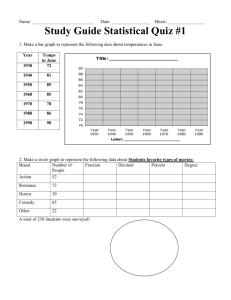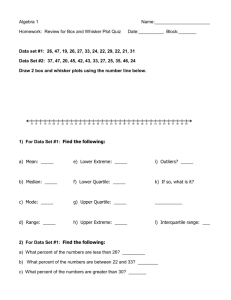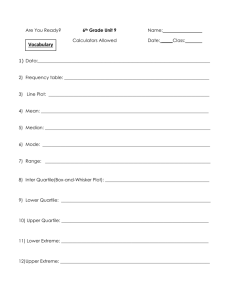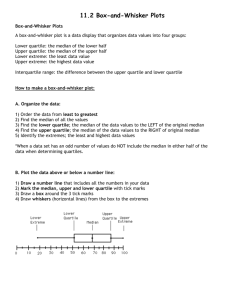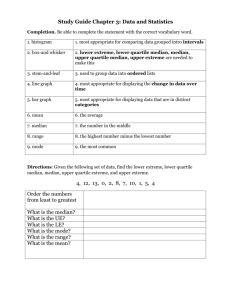SDAP1.1&1.3
advertisement
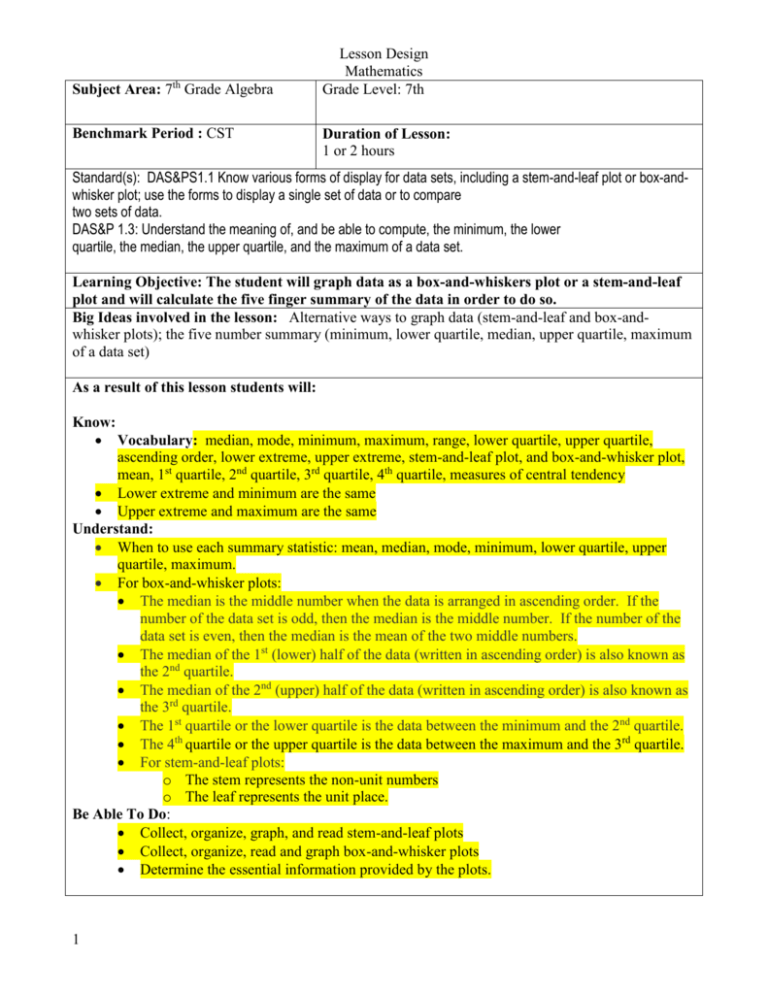
Subject Area: 7th Grade Algebra
Benchmark Period : CST
Lesson Design
Mathematics
Grade Level: 7th
Duration of Lesson:
1 or 2 hours
Standard(s): DAS&PS1.1 Know various forms of display for data sets, including a stem-and-leaf plot or box-andwhisker plot; use the forms to display a single set of data or to compare
two sets of data.
DAS&P 1.3: Understand the meaning of, and be able to compute, the minimum, the lower
quartile, the median, the upper quartile, and the maximum of a data set.
Learning Objective: The student will graph data as a box-and-whiskers plot or a stem-and-leaf
plot and will calculate the five finger summary of the data in order to do so.
Big Ideas involved in the lesson: Alternative ways to graph data (stem-and-leaf and box-andwhisker plots); the five number summary (minimum, lower quartile, median, upper quartile, maximum
of a data set)
As a result of this lesson students will:
Know:
Vocabulary: median, mode, minimum, maximum, range, lower quartile, upper quartile,
ascending order, lower extreme, upper extreme, stem-and-leaf plot, and box-and-whisker plot,
mean, 1st quartile, 2nd quartile, 3rd quartile, 4th quartile, measures of central tendency
Lower extreme and minimum are the same
Upper extreme and maximum are the same
Understand:
When to use each summary statistic: mean, median, mode, minimum, lower quartile, upper
quartile, maximum.
For box-and-whisker plots:
The median is the middle number when the data is arranged in ascending order. If the
number of the data set is odd, then the median is the middle number. If the number of the
data set is even, then the median is the mean of the two middle numbers.
The median of the 1st (lower) half of the data (written in ascending order) is also known as
the 2nd quartile.
The median of the 2nd (upper) half of the data (written in ascending order) is also known as
the 3rd quartile.
The 1st quartile or the lower quartile is the data between the minimum and the 2nd quartile.
The 4th quartile or the upper quartile is the data between the maximum and the 3rd quartile.
For stem-and-leaf plots:
o The stem represents the non-unit numbers
o The leaf represents the unit place.
Be Able To Do:
Collect, organize, graph, and read stem-and-leaf plots
Collect, organize, read and graph box-and-whisker plots
Determine the essential information provided by the plots.
1
Assessments:
What will be evidence of
student knowledge,
understanding & ability?
Anticipatory Set:
a. T. focuses students
b. T. states objectives
c. T. establishes purpose of
the lesson
d. T. activates prior
knowledge
Lesson Design
Mathematics
Formative: Observation, quiz
Summative: CST
Lesson Plan
Teacher has students work on the activity Average Means What? This
reviews for them the three measures of central tendency.
The question becomes, which measure is best used to give us a picture
of the sample. The next question is what would be the best way to
display this data.
Now a review of the three measures may be necessary. For that use
Riverdeep
Instruction:
a. Provide information
Explain concepts
State definitions
Provide examples
Model
b. Check for
Understanding
Pose key questions
Ask students to
explain concepts,
definitions, attributes in
their own words
Have students
discriminate between
examples and nonexamples
Encourage students
generate their own
examples
2
1. Given two sets of data [{6, 8, 8, 10, 7, 4, 9, 8,7} and {6, 8, 8, 10, 7,
4, 9, 8, 7, 5}], the teacher will review with the students how to find the
median. The median is the middle number of a data set arranged in
order from smallest to largest when the number of data is odd, or the
average of the two middle numbers when the number of data is even.
The median of the first set is 8 and the data of the second set is 7.5.
2. Teacher will divide the class into two groups such that one group
has an odd number of students (Group O) and the other group has an
even number of people (Group E).
3. The teacher will help students generate the students’ height in
inches.
4. The students will calculate the median for each group.
The teacher will tell the students that today they are going to learn how
to put data into organized forms. Two of the forms are stem-and-leaf
plots and box-and-whisker plots.
1. The teacher will show the students how to put Group O data into a
stem-and-leaf plot. The teacher will discuss with the students some of
the significant information of stem-and-leaf plot such as minimum,
maximum, mode, etc…
2. The teacher will show the students how to put Group O data into
box-and-whiskers plot. The teacher will discuss with students some of
the significant information of box-and-whisker plot such as median,
minimum (lower extreme), maximum (upper extreme), range, lower
quartile, upper quartile, ascending order, 1st quartile, 2nd quartile, 3rd
quartile, 4th quartile.
Lesson Design
Mathematics
Use participation
Guided Practice:
a. Initiate practice activities
under direct teacher
supervision – T. works
problem step-by-step
along w/students at the
same time
b. Elicit overt responses
from students that
demonstrate behavior in
objectives
c. T. slowly releases student
to do more work on their
own (semi-independent)
d. Check for understanding
that students were correct
at each step
e. Provide specific
knowledge of results
f. Provide close monitoring
What opportunities will students
have to read, write, listen &
speak about mathematics?
Closure:
a. Students prove that they
know how to do the work
b. T. verifies that students can
describe the what and why
of the work
c. Have each student perform
behavior
Independent Practice:
a. Have students continue to
practice on their own
b. Students do work by
themselves with 80%
accuracy
c. Provide effective, timely
feedback
1. Students will make a stem-and leaf plot using the Group E data.
Students will also list some of the important facts they can get from
their graph. When students have finished, the teacher will validate
their answers by putting the same data into a stem-and-leaf plot as a
group.
2. Students will make a box-and whisker plot using the Group E data.
Students will also list some of the essential facts they can get from
their graph. Once students have finished, the teacher will validate their
answers by putting the same data into box-and-whisker plot as a group.
Students will read the graphs, interpret the data, discuss the pertinent
information regarding the plots, summarize the results and work in groups.
The teacher will ask to summarize their findings.
1. The students will combine the data from Group E and Group O to
form a new set of data. The students will make a stem-and-leaf plot,
box-and-whisker plot, and compare the result such as median,
minimum, maximum, range, lower (1st) quartile, upper (4th) quartile,
ascending order, extreme lower quartile (minimum), extreme upper
quartile (maximum) to the results in Group O and Group E.
2. The students will answer the following two questions from CST
released items.
A. The following data represent the number of years different students in a
certain group have gone to school together: 12, 5, 8, 16, 15, 9, 19.
This data is shown on the box-and-whisker plot below.
3
Lesson Design
Mathematics
What is the median of the data?
A5
B8
C 12
D 16
CSN00082
B. The box-and-whisker plot below represents the daily high temperatures at
a beach in April.
Daily High Temperatures
What was the median daily high temperature?
A 68°F
B 72°F
C 78°F
D 84°F
CSM10202
Resources: materials needed
to complete the lesson
4
Lesson Design
Mathematics
5

